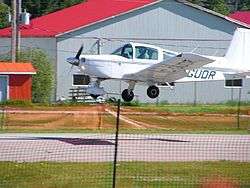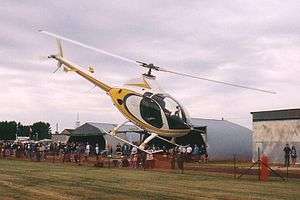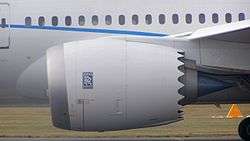Aircraft noise

Aircraft noise is noise pollution produced by any aircraft or its components, during various phases of a flight: on the ground while parked such as auxiliary power units, while taxiing, on run-up from propeller and jet exhaust, during take off, underneath and lateral to departure and arrival paths, over-flying while en route, or during landing.
Mechanisms of sound production


A moving aircraft including the jet engine or propeller causes compression and rarefaction of the air, producing motion of air molecules. This movement propagates through the air as pressure waves. If these pressure waves are strong enough and within the audible frequency spectrum, a sensation of hearing is produced. Different aircraft types have different noise levels and frequencies. The noise originates from three main sources:
- Aerodynamic noise
- Engine and other mechanical noise
- Noise from aircraft systems
Aerodynamic noise
Aerodynamic noise arises from the airflow around the aircraft fuselage and control surfaces. This type of noise increases with aircraft speed and also at low altitudes due to the density of the air. Jet-powered aircraft create intense noise from aerodynamics. Low-flying, high-speed military aircraft produce especially loud aerodynamic noise.
The shape of the nose, windshield or canopy of an aircraft affects the sound produced. Much of the noise of a propeller aircraft is of aerodynamic origin due to the flow of air around the blades. The helicopter main and tail rotors also give rise to aerodynamic noise. This type of aerodynamic noise is mostly low frequency determined by the rotor speed.
Typically noise is generated when flow passes an object on the aircraft, for example the wings or landing gear. There are broadly two main types of airframe noise:
- Bluff Body Noise – the alternating vortex shedding from either side of a bluff body, creates low pressure regions (at the core of the shed vortices) which manifest themselves as pressure waves (or sound). The separated flow around the bluff body is quite unstable, and the flow "rolls up" into ring vortices—which later break down into turbulence.[1]
- Edge Noise – when turbulent flow passes the end of an object, or gaps in a structure (high lift device clearance gaps) the associated fluctuations in pressure are heard as the sound propagates from the edge of the object (radially downwards).[1]
Engine and other mechanical noise
Much of the noise in propeller aircraft comes equally from the propellers and aerodynamics. Helicopter noise is aerodynamically induced noise from the main and tail rotors and mechanically induced noise from the main gearbox and various transmission chains. The mechanical sources produce narrow band high intensity peaks relating to the rotational speed and movement of the moving parts. In computer modelling terms noise from a moving aircraft can be treated as a line source.
Aircraft gas turbine engines (jet engines) are responsible for much of the aircraft noise during takeoff and climb, such as the buzzsaw noise generated when the tips of the fan blades reach supersonic speeds. However, with advances in noise reduction technologies—the airframe is typically more noisy during landing.
The majority of engine noise is due to jet noise—although high bypass-ratio turbofans do have considerable fan noise. The high velocity jet leaving the back of the engine has an inherent shear layer instability (if not thick enough) and rolls up into ring vortices. This later breaks down into turbulence. The SPL associated with engine noise is proportional to the jet speed (to a high power) therefore, even modest reductions in exhaust velocity will produce a large reduction in Jet Noise.
Noise from aircraft systems
Cockpit and cabin pressurization and conditioning systems are often a major contributor within cabins of both civilian and military aircraft. However, one of the most significant sources of cabin noise from commercial jet aircraft, other than the engines, is the Auxiliary Power Unit (APU), an on‑board generator used in aircraft to start the main engines, usually with compressed air, and to provide electrical power while the aircraft is on the ground. Other internal aircraft systems can also contribute, such as specialized electronic equipment in some military aircraft.
Health effects
There are health consequences of elevated sound levels. Elevated workplace or other noise can cause hearing impairment, hypertension, ischemic heart disease, annoyance, sleep disturbance, and decreased school performance. Although some hearing loss occurs naturally with age,[2] in many developed nations the impact of noise is sufficient to impair hearing over the course of a lifetime.[3][4] Elevated noise levels can create stress, increase workplace accident rates, and stimulate aggression and other anti-social behaviors.[5]
German environmental study
A large-scale statistical analysis of the health effects of aircraft noise was undertaken in the late 2000s by Bernhard Greiser for the Umweltbundesamt, Germany's central environmental office. The health data of over one million residents around the Cologne airport were analysed for health effects correlating with aircraft noise. The results were then corrected for other noise influences in the residential areas, and for socioeconomic factors, to reduce possible skewing of the data.[6]
The German study concluded that aircraft noise clearly and significantly impairs health.[6] For example, a day-time average sound pressure level of 60 decibel increasing coronary heart disease by 61% in men and 80% in women. As another indicator, a night-time average sound pressure level of 55 decibel increased the risk of heart attacks by 66% in men and 139% in women. Statistically significant health effects did however start as early as from an average sound pressure level of 40 decibel.[6]
FAA advice
The FAA says that a maximum day-night average sound level of 65 dB is incompatible with residential communities.[7] Communities in affected areas may eligible for mitigation such as soundproofing.
Inside aircraft
Noise associated with aircraft does not only affect people on the ground, but also those within the aircraft (e.g., flight crew, cabin crew and passengers). While there appears to be little research in this area, lower noise inside the aircraft is widely promoted as a benefit for new aircraft. The noise levels inside an Airbus A321 during cruise have been reported as approximately 78 dB(A). During taxi when the aircraft engines are producing minimal thrust, noise levels in the cabin have been recorded at 65 dB(A).[8] This is approximately 20 decibels louder than recommended acceptable levels for an office but 20 decibels below the occupational noise exposure limits of 85 dB(A).[9]
Cognitive effects
Simulated aircraft noise at 65 dB(A) has been shown to negatively affect individuals’ memory and recall of auditory information.[10] In one study comparing the effect of aircraft noise to the effect of alcohol on cognitive performance, it was found that simulated aircraft noise at 65 dB(A) had the same effect on individuals’ ability to recall auditory information as being intoxicated with a Blood Alcohol Concentration (BAC) level of at 0.10.[11] A BAC of 0.10 is double the legal limit required to operate a motor vehicle in many developed countries such as Australia.
Noise mitigation programs

In the United States, since aviation noise became a public issue in the late 1960s, governments have enacted legislative controls. Aircraft designers, manufacturers, and operators have developed quieter aircraft and better operating procedures. Modern high-bypass turbofan engines, for example, are quieter than the turbojets and low-bypass turbofans of the 1960s. First, FAA Aircraft Certification achieved noise reductions classified as "Stage 3" aircraft; which has been upgraded to "Stage 4" noise certification resulting in quieter aircraft. This has resulted in lower noise exposures in spite of increased traffic growth and popularity.[13]
In the 1980s the U.S. Congress authorized the FAA to devise programs to insulate homes near airports. While this does not address the external noise, the program has been effective for residential interiors. Some of the first airports at which the technology was applied were San Francisco International Airport and San Jose International Airport in California. A computer model is used which simulates the effects of aircraft noise upon building structures. Variations of aircraft type, flight patterns and local meteorology can be studied. Then the benefits of building retrofit strategies such as roof upgrading, window glazing improvement, fireplace baffling, caulking construction seams can be evaluated.[14]
Night flying restrictions
At Heathrow, Gatwick and Stansted airports in London, UK and Frankfurt Airport in Germany, night flying restrictions apply to reduce noise exposure at night.[15][16]
Satellite-based navigation systems
A series of trials were undertaken at London's Heathrow Airport, between December 2013 and November 2014, as part of the UK's "Future Airspace Strategy", and the Europe-wide "Single European Sky" modernisation project. The trials demonstrated that using satellite-based navigation systems it was possible to offer noise relief to more surrounding communities. The study found that steeper angles for take-off and landing led to fewer people experiencing aircraft noise and that noise relief could be shared by using more precise flight paths, allowing control of the noise footprint of departing aircraft. Noise relief could be enhanced by switching flight paths, for example by using one flight path in the morning and another in the afternoon.[17]
See also
- Electric airplane
- Farley v Skinner
- Hush kit
- Helicopter noise reduction
- Jet noise
- Noise barrier
- Rotor-stator interaction
- Silent Aircraft Initiative
- Train noise
- XF-84H Thunderscreech, the loudest aircraft ever built.
General:
References
- 1 2 "Aircraft Airframe Noise - Research Overview". Retrieved 2008-07-13.
- ↑ Rosenhall U, Pedersen K, Svanborg A (1990). "Presbycusis and noise-induced hearing loss". Ear Hear. 11 (4): 257–63. doi:10.1097/00003446-199008000-00002. PMID 2210099.
- ↑ Schmid, RE (2007-02-18). "Aging nation faces growing hearing loss". CBS News. Archived from the original on November 15, 2007. Retrieved 2007-02-18.
- ↑ Senate Public Works Committee, Noise Pollution and Abatement Act of 1972, S. Rep. No. 1160, 92nd Cong. 2nd session
- ↑ Kryter, Karl D. (1994). The handbook of hearing and the effects of noise: physiology, psychology, and public health. Boston: Academic Press. ISBN 0-12-427455-2.
- 1 2 3 Tödlicher Lärm - Spiegel, Nr. 51, 14 Dezember 2009, Page 45 (German)
- ↑ "Noise Monitoring". Massport. Retrieved 31 January 2014.
- ↑ Ozcan HK, Nemlioglu S. In-cabin noise levels during commercial aircraft flights. Can Acoust 2006;34:31-5.
- ↑ Standards Australia, AS/NZS 2107. Acoustics-Recommended Design Sound Levels and Reverberation Times for Building Interiors. AUS: Standards Australia, Sydney; 2000.
- ↑ Molesworth BR, Burgess M. (2013). Improving intelligibility at a safety critical point: In flight cabin safety. Safety Science, 51, 11-16.
- ↑ Molesworth BR, Burgess M, Gunnell B. (2013). Using the effect of alcohol as a comparison to illustrate the detrimental effects of noise on performance. Noise & Health, 15, 367-373.
- ↑ Zaman, K.B.M.Q.; Bridges, J. E.; Huff, D. L. "Evolution from 'Tabs' to 'Chevron Technology'–a Review" (PDF). Proceedings of the 13th Asian Congress of Fluid Mechanics 17–21 December 2010, Dhaka, Bangladesh. NASA Glenn Research Center. Cleveland, OH. 1.34 Mb
- ↑ "Stage 4 Aircraft Noise Standards". Rgl.faa.gov. Retrieved 2012-09-28.
- ↑ Hogan, C. Michael and Jorgen Ravnkilde, Design of acoustical insulation for existing residences in the vicinity of San Jose Municipal Airport, 1 January 1984, FAA grant-funded research, ISBN B0007B2OG0
- ↑ Dept for Transport (June 2006). "Night flying restrictions at Heathrow, Gatwick and Stansted Airports". Archived from the original on July 17, 2007. Retrieved 2008-07-12.
- ↑ Dept for Transport (n.d.). "Night restrictions at Heathrow, Gatwick and Stansted (second stage consultation)". Retrieved 2008-07-12.
- ↑ "Modernising UK airspace". heathrow.com. Retrieved 24 September 2015.
- U.S. Noise Control Act of 1972 United States Code Citation: 42 U.S.C. 4901 to 4918
- S. Rosen and P. Olin, Hearing loss and coronary heart disease, Archives of Otolaryngology, 82:236 (1965)
External links
- Airbus Noise Technology Centre United Kingdom
- Airport Noise Law United States
- EASA approved noise levels Germany
- Federal Interagency Committee on Aviation Noise (FICAN)
- Aviation Environment Federation (AEF) United Kingdom
- Sound Initiative: A Coalition for Quieter Skies United States
- Airport Noise Report A weekly newsletter on litigation, regulations, and technological developments
- National Organization to Insure a Sound-controlled Environment(NOISE) United States
- Attitudes to Noise from Aviation Sources in England (ANASE) Study published by the United Kingdom Department for Transport
- The 'Silent' Aircraft Initiative
- Cruise altitude plane noise example